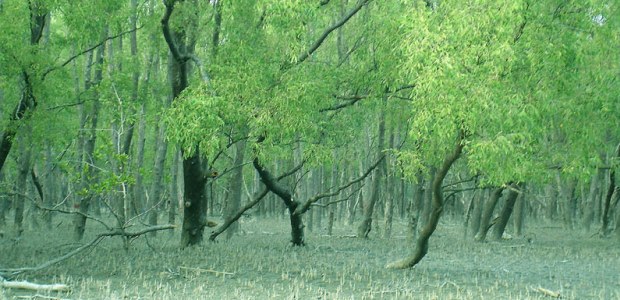
Unique Biodiversity of Bangladesh's Sundarbans Forest is Threatened
A Khulna University team's study reveals the food chain of aquatic species living in the Sundarbans has been severely disrupted by the December 2014 Sela River oil spill.
In the early morning of Dec. 9, 2014, foggy weather in the estuarine waters of the Sela River caused a cargo ship to ram an oil tanker. It leaked about 350,000 liters (75,000 gallons) of furnace oil, which contaminated the land and water of the world-famous Sundarbans tidal mangrove forest of Bangladesh.
The spilled oil has already spread to 500 square kilometers of the forest and would have a long-term adverse effect on its biodiversity, including fish and animals, in the affected areas, according to a study conducted by the Environment Science Department of Khulna University (KU).
Sundarbans contains two Bangali words (Bangladesh's national language): Sundar means Beautiful and Bans means Forests. The Sundarbans of Bangladesh is the largest mangrove forest in the world, vital for supporting hundreds of species. Many of these are endangered, according to the IUCN Red List, such as the Royal Bengal tiger, Ganges and Irrawaddy dolphins, estuarine crocodiles, and endemic river terrapin. The majestic Royal Bengal tiger population of this forest is the largest remaining population in the world.
The Wildlife Conservation Society (WCS) discovered an astonishing population of 6,000 Irrawaddy dolphins in the Bangladesh Sundarbans in 2011. As a result, an effort has been made to conserve the marvelous dolphins by declaring Dhangmari, Chandpai, and Dudhmukhi areas of eastern Sundarbans as dolphin sanctuaries. For its remarkable biodiversity and uniqueness, UNESCO has declared this Sundarbans ecosystem as a World Heritage site.
This unique biodiversity is under severe threat due to the oil spill. Experts warned serious consequences, both short-term and long-term, for the disaster. Dr. Atiq Rahman, executive director of the Bangladesh Centre for Advanced Studies (BCAS), said, "The environmentalists repeatedly warned the government that carrying fuel and coal through the Sundarbans water routes may cause havoc for the forests, and the recent tanker crash has proved it."
Necropsies on two otters recovered by forests department workers from the Sela River in the Sundarbans on Dec. 18 confirmed that they had died from ingesting oil.
A 10-member team led by Prof. Dr. Abdullah Harun Chowdhury of Khulna University has been performing a study on effect of the oil spill in 1,200 square kilometres area of the Sundarbans. Before the spill, oil was present in concentrations 2 and 4 milligrams in per kilogram of soil. Now, it has reached 370 to 1,690 milligrams per kilogram of soil, exceeding the international oil contamination standard limit of 10 milligrams per liter. The study reveals the food chain of aquatic species living in the Sundarbans has been severely disrupted by the Sela River oil spill. A typical liter of water normally contains 226-456 units of phytoplankton and zooplankton with an abundance of 53-77 units per liter. After oil disaster, phytoplanktons dropped to 24-67 units per liter and zooplanktons to 6-10 units per liter. These are the primary producer of the ecosystem, thus the entire food chain would be affected severely.
Three to seven mudskippers were noticed per square meter in normal conditions, but after the oil spill, no mudskippers were observed. Crabs also disappeared from the affected area, while normally three to seven crabs are found per square meter. Researchers could not see any dolphins in oil spill areas of the Sundarbans, but generally, 5 to 10 dolphins were seen in the river per hour. The area usually is occupied by groups of browsing deer; the team also did not see any footprints of deer in the affected area. All of the symptoms demonstrate the damage to the food chain caused by the spilled oil. Much more evidence of the destructive impacts of the oil spill is yet to be revealed.
The UN expressed concern over the disaster, urging Dhaka, seat of the Bangladeshi government, to impose a "complete ban" on the movement of commercial vessels through the 10,000-square-kilometer (3,850 square miles) forest, but the Shipping Ministry rejected this recommendation. Minister Shahjahan Khan said, "Human need is our first concern, not the forest." This kind of irresponsible comment is not unexpected from a powerful politician.
For the time being, it is clear that the route would not be changed unless there is heavy international pressure. World leaders, scientists, and others concerned about the spill's impact should come forward to save the Sundarbans before it is too late.
About the Author
Abu Saleh Md Golam Kibria is a Ph.D. candidate at The Australian National University in Canberra, Australia.